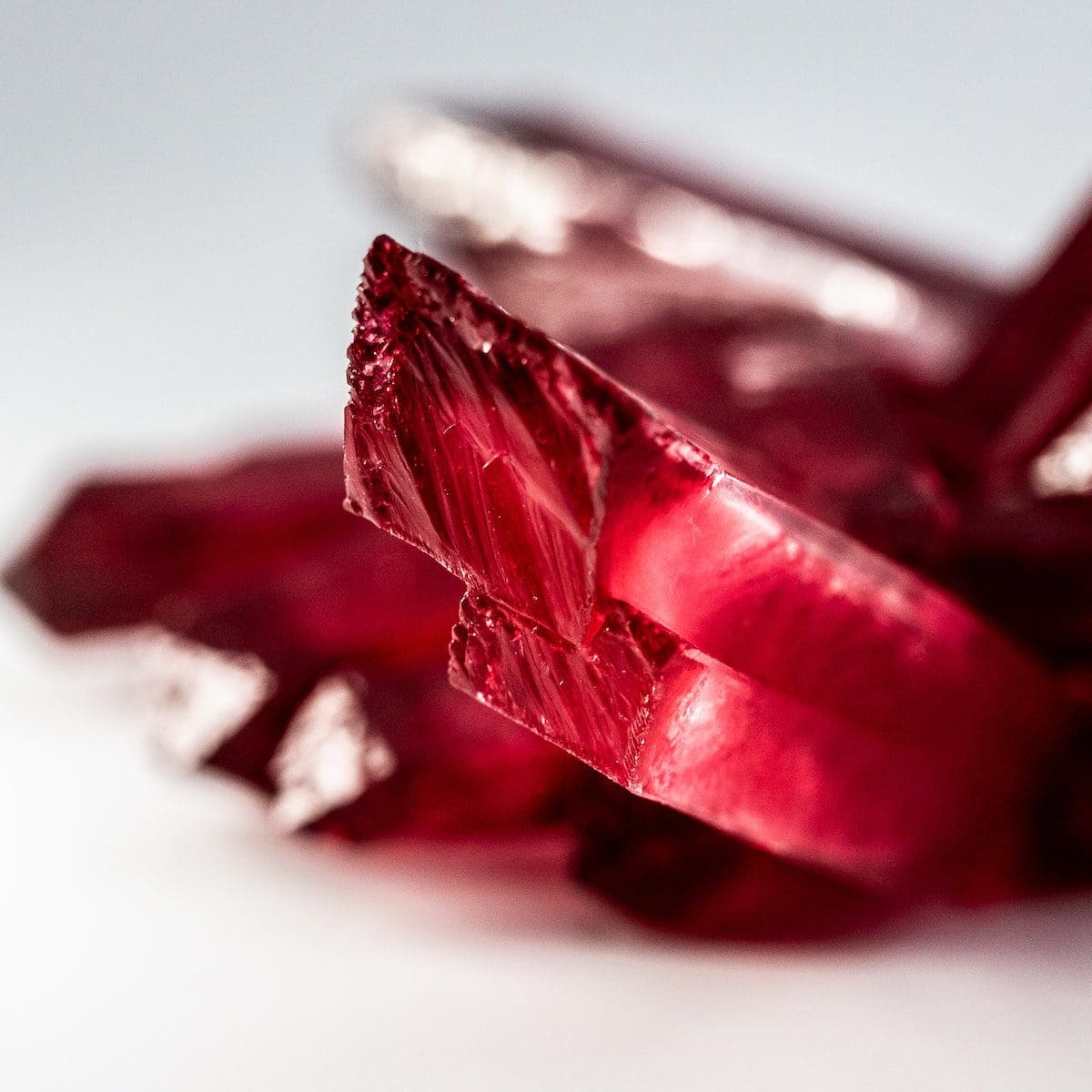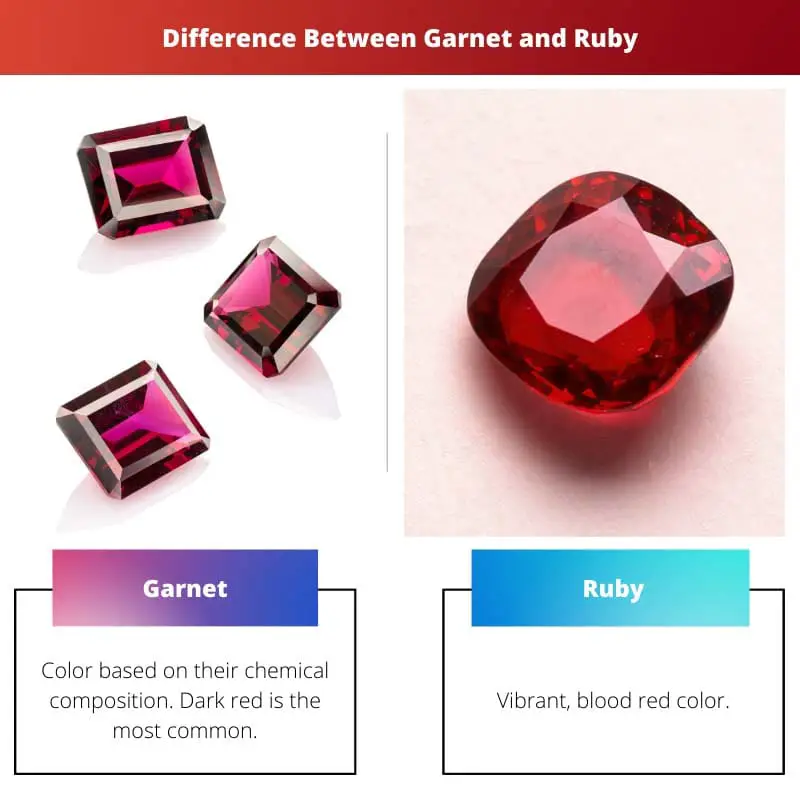When any part of a mineral, rock or other organic material is cut, polished and smoothened and turned into a piece of a precious jewel, it is known as a gemstone. Garnet and Ruby are two such examples of gemstones.
Both of these gemstones look very similar to each other in the flick of an eye because of their red color, but if we look closer, we will find out that Rubies have a more vibrant red color and are considered one of the most precious gemstones, whereas Garnets have a tinge of orange, yellow, brown, etc. added to the red color and are considered as semi-precious gemstones.
Key Takeaways
- Garnets are silicate minerals in various colors, while rubies are corundum, exclusively red.
- Rubies have a higher Mohs hardness scale rating (9) than garnets (6.5-7.5), making them more durable.
- Rubies are more valuable and rare, used in high-end jewelry, whereas garnets are more affordable and common.
Garnet vs Ruby
The difference between Garnet and Ruby is that Rubies are preceded by diamonds (which are known as the hardest substance on this planet) and are very hard and durable, but Garnets are not as hard as compared to Rubies, they’re softer gemstones. Rubies belong to the mineral group called corundum and are known as ‘’king of the gems’’, whereas Garnets belong to the group of silicate minerals.

Garnets are widely found in different varieties and different colors like shades of red, pink, brown, purple, yellow, green, violet, greenish-blue, etc.
The color and type of Garnet determine whether they are rare or common, or expensive. Clear, peach and green Garnets are the rarest of the lot, while the ones similar to Rubies are more common.
Rubies are very expensive and symbolize spiritual wisdom, passion and love, power and wealth. According to some people, Rubies have protective qualities too.
According to Hindus, the very rich and vibrant flame-like red color of Ruby signifies the inner flame and passion of a human who can never be dampened. Rubies which have a brighter red color and the color is very clear are the most expensive ones.
Comparison Table
| Parameters of Comparison | Garnet | Ruby |
|---|---|---|
| Color | Color based on their chemical composition. Dark red is the most common. | Vibrant, blood red color |
| Treatment | Most of them are 100% natural | Most of them are heat treated to make the stone look clearer and more vibrant |
| Light | Garnets reflect hues of yellow and green when held up to the light | Rubies absorb the yellow and green hues so they don’t reflect them |
| Durability | It is much softer as compared to a Ruby and needs extra care | Rubies are considered to be the second toughest substance on the planet |
| Rarity and Value | Garnets can be very commonly found and have a lesser value than Rubies | Rubies are comparatively rarer and are very expensive and valuable. It is a royal gemstone. |
What Is Garnet?
The word garnet is derived from the 14th-century Middle English word gernet which means ‘’dark red’’. They belong to the group of silicate minerals, and their use dates back to the Bronze Age.
There are different species of garnet, such as- pyrope, almandine, spessartine, grossular, uvarovite, andradite and many more.
These different species share similar physical properties but different chemical composition. And these species are found in almost all colors, red being the most common of them all.
Besides being used as gemstones, garnets(almandine for its hardness) are also used for industrial purposes as abrasives for grinding and polishing.
They are almost never found in their pure state. Garnets emit a lustre or shine, which is either known as glass-like shine(very transparent, crystal clear) or amber-like(very tarry, sticky-like).
There are also some types of garnets that are not gems, like goldmanite, henritermierite, kimzeyite, majorite, schoolmate, and yamatoite.
Different species of garnets create a blend with each other and give rise to blend garnets like Rhodolite (blend of pyrope and almandine with a purplish hue), Malaya(blend of pyrope and spessartite), color change garnet (the ones discovered in Idaho are a blend of almandine and pyrope and the ones discovered in Madagascar are a blend of pyrope and spessartite), Almandine-spessartite and Almandine-grossular(grandite).
Garnets have also been grouped according to their chemical composition by some gemologist, like pyralspites (for pyrope, almandine and spessartite) and ugrandites (uvarovite, grossular, and andradite).
Garnet is also considered the birthstone of January, and in Persia, it was considered to be a lucky charm and protection against natural forces like lightning and storms.
Some varieties of garnets are hard, while some are soft and heat sensitive. So extra care is needed for the more delicate ones by cleaning them with lukewarm water, detergent and a soft brush.

What Is Ruby?
The word ‘’ruby’’ is derived from the Latin word ‘’ruber’’, meaning red. This gemstone was discovered around 2000 years ago and has always been the choice of the royal people and people in power and love, therefore it is considered as a very important, precious and one of the cardinal gems, along with sapphire, emerald, and diamond.
The ancient kings and royal families of India believed that Rubies were endowed with powerful properties and magical powers which would bring wealth, love and prosperity. Therefore, their crowns, daggers and jewellery were embellished with rubies.
It is a very ornamental and oriental stone and was also mentioned in the Bible(The Book of Exodus and The Book of Proverbs).
Rubies are very hard and strong gemstones and are ranked 9th on the Mohs scale of mineral hardness (diamond being the hardest, 10.0).
Some of the best quality rubies come from Myanmar, and they are also found in countries like Mozambique, Kenya, Thailand, Afghanistan, Pakistan, India, Nepal, etc. The most famous type of rubies are formed as marbles.
These marbles are produced due to a metamorphic process when mountains are formed, generating a lot of heat and pressure. Ruby belongs to the mineral group of corundum and, in its purest state, is colorless.
Chromium is the element that gives ruby its vibrant red color. The quality and value of a ruby depend on its color, cut, clarity and carat.
The Sunrise Ruby is the world’s most expensive and valuable ruby. Ruby is also considered to be the stone of The Sun. Like the Sun is the source of energy and symbolizes passion, power, and respect, Ruby is also said to possess such qualities.
Rubies are also considered to be the most emotionally powerful gemstones and possess qualities which can ignite love, passion and warmth between people, and serve as the most appropriate gift for any romantic gesture.

Main Differences Between Garnet and Ruby
1. Rubies have a vibrant, pigeon-blood-like color whereas garnets are found in almost all colors. Red garnets are the most commonly found garnets, and there is a slight tint of earthly tones to the red.
2. Rubies are relatively stronger and harder, and more durable than Garnets.
3. When held under a light, Rubies reflect many shades of red and blue, whereas Garnets reflect many shades of yellow and green. Rubies are double-refractive stones, while garnets are single-refractive stones.
4. Rubies tend to exhibit numerous internal formations or flaws which are considered to be their natural characteristic, whereas Garnets don’t have such internal formations or inclusions and are very clear and clean.
5. Almost all Rubies are heat treated to enhance the vibrancy of the color red and improve the clarity, whereas Garnets lack such internal inclusions so they are not treated and exist in their pure state.





